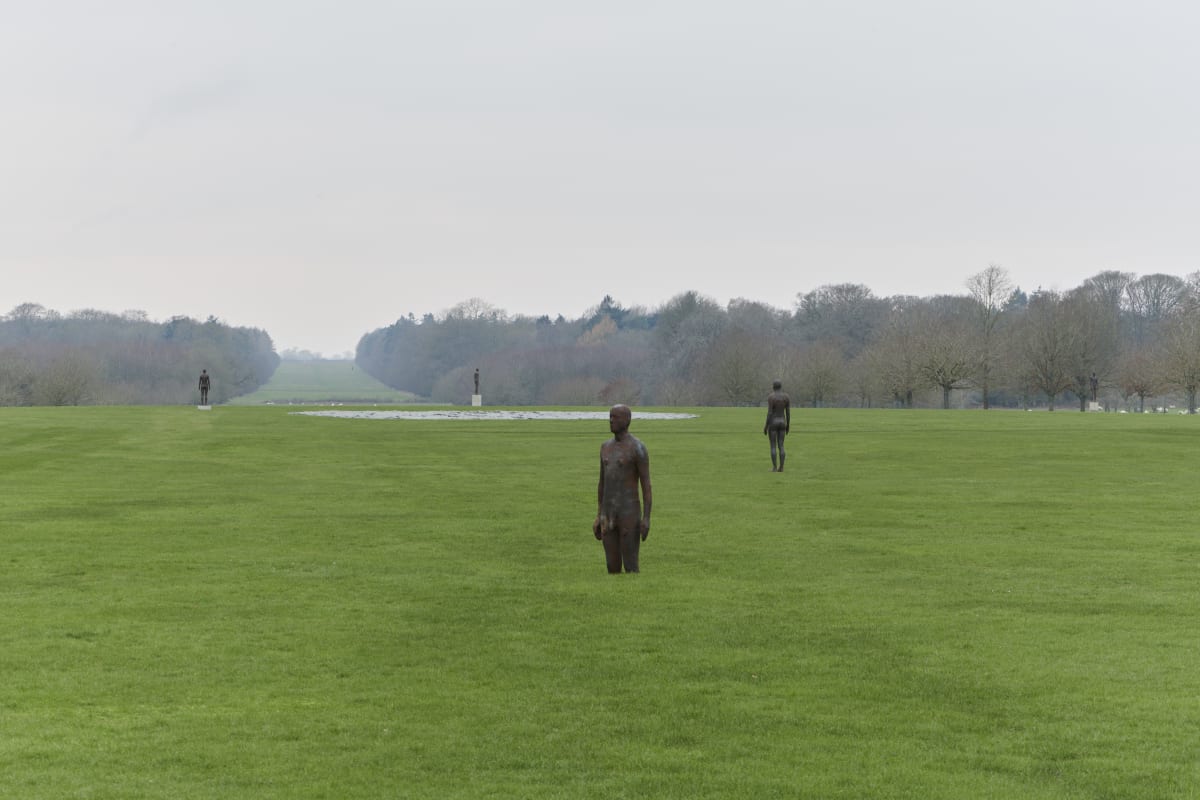Antony Gormley changed how I think about art Review of 'Time Horizon' at Houghton Hall
'It is only the thoughts and feelings that arise in the viewer that give this work meaning," the British artist says about Time Horizon. At Houghton Hall, I start to understand what he means.
By Emily Bootle
Standing in the sweeping grounds of Norfolk’s Houghton Hall on a blustery day in early April, Antony Gormley is explaining something. Unlike most famous people, the British artist is taller than you expect – although I should have known exactly how tall he was, given the number of his self-modelled cast-iron statues I’ve seen in my life. He’s wearing a practical windbreaker jacket with a scarf, looking both imposing – he is a Sir, after all – and perfectly down-to-earth. Quite literally, since a hundred casts of his naked body are configured around us, up to a mile away, many half-buried in the ground.
What he’s saying is that this work, Time Horizon, is only just beginning, as I and a coachload of journalists and bona fide Art People explore it at its first preview day. “The work itself has no intrinsic value,” he says. “It is only the thoughts and feelings that arise in the viewer that give this work meaning.”
If you were an especially cantankerous undergraduate or bored dinner-party attendee, you could probably argue that this is true of all art. But it’s an idea that applies particularly readily to Gormley’s work, rooted as it is so firmly in time and space; our subjective experience of art is inextricable from the circumstances in which we encounter it.
Gormley’s sculptures are often installed in places where they can enhance the landscape – his most famous work, Angel of the North, set back from the A1 greeting travellers to Tyneside, is most often experienced as a notable view from the car window – or become one with it. I’m thinking particularly of Another Place, Gormley’s installation on Crosby beach in Merseyside, at which I had something of a religious experience back in 2017.
A hundred of Gormley’s now-trademark cast-iron figures stand in rows along the beach, looking out to sea. They are engulfed by sand and the tide, having been weathered, covered in lichen and barnacles. It gives me a shiver just to imagine it: Crosby beach is a vast, windswept place, with Liverpool’s industrial docklands in the background. The figures stare blankly at the sea, powerless against the waves, engulfed and then revealed again in a changed state. It’s one of the most moving and existential artworks I’ve ever seen.
Walking around the exhibition at Houghton I am struck more than ever by just how significant the setting of an artwork can be to its reception. The contrast between these two similar works – both use Gormley’s self-modelled iron men – demonstrates exactly Gormley’s point: how the location, and therefore your experience, of a piece can change its meaning so fundamentally.
Time Horizon has been shown before, at an archaeological site in southern Italy. Its appearance at Houghton makes it one in a long line of exhibits hosted every summer by Lord Cholmondeley, formerly the Lord Great Chamberlain until the death of Elizabeth II in 2022, to whom Houghton – which is a few miles from the royal Sandringham estate, and surrounded by a cool 1,000 acres of private parkland – is one of two family seats: it is a stately home, in other words, that retains the essence of a British aristocracy on the verge of extinction.
He is a descendent of Robert Walpole, the first prime minister, for whom the vast, imposing house was built in 1722 (and naturally, clad in a brown corduroy suit and with wafting schoolboy hair, he is a warm, affable host). Just like at its original showing among the Roman ruins of Catanzaro, Time Horizon is here designed to set off the stark figures in a site of human habitation.
There is something that feels almost radical about Time Horizon installed here – as though it’s deconstructing the very ground on which it’s built. Its “datum” statue is set smack-bang in the middle of the ground floor of the house, visible from the lawns either side through a tunnel created by two open doors, and buried to the waist through an artfully cut flagstone. Crucially, it sets the height for the remaining 99, which are in varying states of protrusion from the ground.
This makes you question the evenness of the land: you presume, in Norfolk, it will be very flat, but in fact, when you see one statue standing on a two-metre plinth and one not far away buried to the neck, you realise this is not the case. The house, Gormley explains, becomes an image of itself – the figures represent traces of humanity that make us question the preservation of history as an absolute good. And their puncturing of the earth invites us to think about the intersection of human time and geological time, particularly, Gormley says, at a time of extreme climate crisis.


















































































































































































